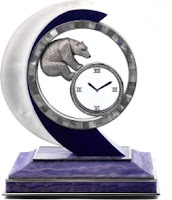Copyright © Francoise Herrmann
Whether it was a fascination with illusions and magic, or because the mechanical aspects of a clock were perceived as aesthetically incompatible with the artistic beauty of jewelry, many watches and clocks of the early 20th century concealed all of the gears and cogwheels of the designs. Indeed, it was even perceived unsightly for women to wear timepieces, and so Van Cleef & Arpels began creating women’s watches where not only the gears, but also the dials, were completely hidden, albeit accessible, within mesmerizing bracelets and necklaces.
 |
| Galileo Clock 1998 |
In any event, the technical craftsmanship involved in concealing the driving mechanisms of timepieces, in pedestals for example, or in creating the illusion of magical mechanics, produced timepieces that became known as “mystery clocks”, in the 1920s.
Scrolling forward in time, as part of the 100-year celebration of Van Cleef & Arpels, the company revisited the mystery clock with the creation of the Galileo Clock. This mystery clock features a bear concealing all the gears, but the bear is no longer an ornamental part of the pedestal, connected the dial frame, which it drives. The bear also also orbits around a frame, together with the dial, and sparkles with diamonds. Thus, there are two concealed and nested mechanisms, one in the surrounding frame, driving the bear, and one inside the bear, driving the dial frame, and the two hands of the clock,
This double mystery clock invention was disclosed in the US utility patent US5878003, titled Mystery Clock, and filed in 1996.
The abstract of this patent is included below with two of the figure drawings, respectively showing the bear and dial within the driving frame (Fig. 1), and the gears within the bear (Fig. 3) driving the dial and the clock hands. An image of the embodiment of this invention, marketed as the Van Cleef & Arpels 1998 Galileo Clock, is also included above.
A clock, called a "mystery" clock because of its almost totally transparent nature, comprising a transparent dial bearing reference markers (11), a minute indicator, transparent except in the area of a reading pointer (28') and an hour indicator, also transparent except in the area of a reading pointer (26'), indicators and dial having a common geometric axis (Y) and being carried by a frame or surround (20) and at least part of these indicators and dial having teeth at their periphery, masked by the surround (20), for driving them in rotation, in relation to the surround (20), about said axis (Y). [Abstract US5878003]
Reference
Van Cleef & Arpels - Mysterious clocks
Van Cleef & Arpels - The Beginnings of Watchmaking


1 comment:
eksc214uu
golden goose outlet
golden goose outlet
golden goose outlet
golden goose outlet
golden goose outlet
golden goose outlet
golden goose outlet
golden goose outlet
golden goose outlet
golden goose outlet
Post a Comment